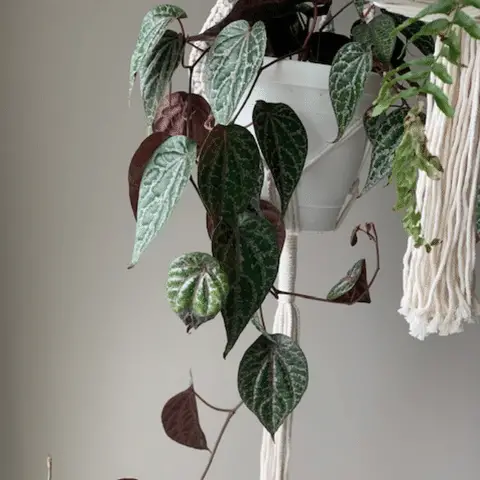When decorating my office with plants, I decided to diversify and play with different shades of color. My eye fell on the Piper crocatum plant, which is not your typical office plant. This beautiful plant is not among the easiest to grow, and I would not suggest it for a beginner; however, how could I resist not buying this stunning beauty?
The Piper Crocatum has beautiful, heart-shaped pointed leaves of dark green color with showy silver-pink veins. The back of the leaves is s purple/burgundy giving this plant a unique touch.
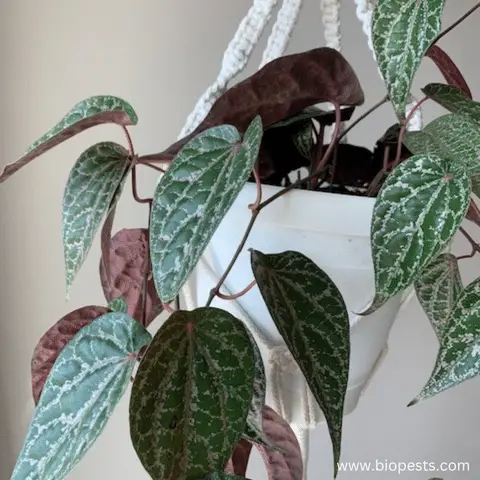
The leaves can become quite large (up to 4.7 inches – 12 cm), adding a dramatic effect.
This genus of plants is native to tropical areas and includes about 700 different species! Among these, the most widespread and known plants are the Piper crocatum and the Piper ornatum, which I will discuss later in my article. The Piper crocatum plant has creeping stems, so it is necessary to hang it in suspended pots or provide support to climb.
Is It Difficult To Grow A Piper Crocatum Indoors?
It is possible to cultivate a Piper Crocatum plant indoors, provided you ensure the necessary temperature, humid environment, and plenty of light. Keep in mind that this plant needs DEDICATION.
As I said before, this plant is not among the easiest plants to grow because it has unique needs. The most common problem with this plant is that if you do not meet its growing requirements its leaves will soon get brown tips and start falling off.
Reasons Why Piper Crocatum Leaves Fall Off
Let’s talk about the pesky issue that many of us face with the piper crocatum plant. It’s heartbreaking to see our beloved plant lose a third or even half of its leaves when it’s feeling stressed (especially right after we bring it home). But here’s the good news: this is a super common problem that many plant parents experience in the beginning. So don’t let it get you down!
Let’s see step by step how to take care of the Piper Crocatum plant and prevent leaves from falling off:
Piper Crocatum Temperature and Humidity Requirements
This plant has a “pantropical” distribution, meaning you can find it in all the regions surrounding the Equator, which have a hot and humid climate. This means that you need to recreate the same conditions indoors. This plant cannot tolerate temperatures below 60 F (16 Celsius) and thrives in a warm climate.
Do not expose the plant to drafts. Most leaves will fall if the plant is subjected to sudden changes in temperature. In addition, low or too-dry temperatures prevent the leaves from developing. So, if you’re keeping your plant in an area that’s too cold or too hot, consider moving it to another area of your home, depending on the weather.
Although the Piper crocatum loves heat, it cannot tolerate an arid environment, and you must ensure it is kept constantly moist.
The piper crocatum plant thrives in a humid environment. Low humidity can cause its leaves to dry out and fall off. If you live in an area with low humidity, you can use a humidifier to increase the moisture around your plant. You can also place a tray of water near your plant, or mist its foliage regularly to increase humidity.
In a nutshell, this plant appreciates constant humid and well-lit environments (such as the bathroom at home).
Piper Crocatum Light Requirements
The Piper Crocatum loves lots of bright, indirect light. Therefore, it will be necessary to place the plant near a light source, not exposing it to direct sunlight. In countries with a hot climate, particular attention must be paid in the hot afternoon hours, when the sun’s rays penetrate the windows and can cause damage to the leaves.
If you’re not providing enough light to your plant, its leaves may start drooping and eventually fall off. The plant’s leaves will also show signs of discoloration if it’s not getting adequate light.
Piper Crocatum Watering Requirements
Piper crocatum plants prefer slightly moist soil. Overwatering can cause the soil to become waterlogged, leading to root rot and eventually causing the plant’s leaves to fall off. To avoid this, make sure you’re not watering the plant too frequently or using a pot without proper drainage. Your plant’s soil should be aerated, well-draining, and you should only water it when the top 1 to 2 inches of soil have become dry.
Piper Crocatum Feeding Requirements
It is possible to give Piper Crocatum a common houseplant fertilizer every two or three weeks. There is no need to administer fertilizer in the winter because the plant is in vegetative rest.
Have you ever considered using bone meal as an organic fertilizer? Discover the amazing benefits of bone meal in this must-read blog post right here!
Potting and Repotting Requirements
There is no need to repot this plant very often. Being a plant that loves moisture, the root system of the Piper crocatum is relatively shallow. This is because the water is usually on the surface, therefore the plant does not have to develop a deep root system to find water.
Repotting should only be done when you see that the plant has grown exponentially and there is no more room for the roots in the pot. The repotting of these plants can be done at any time except in winter using a well-draining potting mix.
Piper Crocatum Propagation
The Piper crocatum is relatively easy to propagate by cuttings, and it is certainly the preferable method since doing it by seeds would be too time-consuming.
Choose a stem that is mature with healthy leaves. Cut right below the plant node and put the piece in a water-filled jar. Place the jar into a warm, bright room (with no direct sunlight). The new roots will shoot in about 4 to 6 weeks, then the cuttings will be ready to be repotted in soil. It is possible to repot the seedling in a larger pot when the plant has reached 2 to 3 inches (5-8 cm) in height.
Piper Crocatum Soil Requirements
The charismatic piper crocatum plant thrives in soil that strikes the perfect balance between moisture and drainage. Avoid the use of dense soil, such as gardening soil, as it puts stress on the plant, hindering its growth and potentially leading to root rot. Personally, I have a soft spot for this particular potting soil.
What Plant Can Grow Next To A Piper Crocatum?
Given the particular growing conditions of the Piper crocatum, I dedicated a corner of my office to all the plants that require similar conditions and won’t mind some misting from time to time. For my plant, I chose a lovely hanging planter. Now my Piper Crocatum is happily sharing its space with a fern, a Devil’s ivy, a Pilea hitchcockii, and different species of Nerve plants.
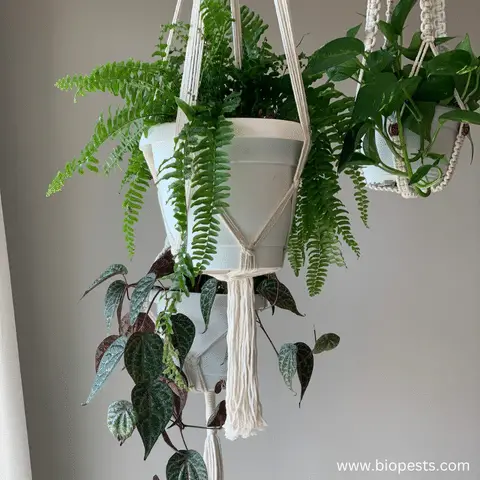
By the way, I will never get tired of praising these white macrame plant hangers, which added the boho-style touch I was looking for in my office. They come as a set. Here is a picture of when I unpacked them:

What Are Piper Crocatum Common Diseases and Pests?
Despite being quite a robust plant, the Piper crocatum is still affected by common pests such as aphids, mealybugs, thrips, and more. In my case, I discovered a nice little colony of aphids the first week I brought the plant in (kindly donated by my plant nursery, free of charge!). Luckily, I removed the pests by wiping the leaves and the stems with a cloth soaked with insecticidal soap. If you are wondering, I wrote an article with recipes on how to make homemade insecticidal soap. You can read it here.
Piper Crocatum Brown Tips And Brown Leaves
Here comes the tricky part, that makes this plant the Prima Donna of house plants. It may take a while to understand if you are overwatering or underwatering your plant. For me, it was almost like bringing a newborn into the house. Sadly, by the time I understood its needs, all the leaves had brown tips.
So… I warned you.
This plant suffers greatly from root rot. If you see that the leaves are turning completely brown (really fast), it means that you are overwatering the plant and that you should check the roots, to see if they are showing signs of decay.
Piper Crocatum Yellowing Leaves
Another common problem for this plant is the yellowing of its leaves. This might be caused by excessive or insufficient watering, excessive or insufficient sunlight, improper drainage, or root decay.
Just as I said before… a real Diva! Try to make some changes to the plant’s water regime, check its roots, and see if there are any improvements.
Why Does My Piper Crocatum Have Tiny Little Specks On Its Leaves And Stem?
Anyone who owns a Piper crocatum must have wondered what are those tiny opaque dots on the stems and under the leaves. Often, these are mistaken for a colony of pests. Luckily, there is nothing to worry about. This is a natural phenomenon called cystoliths, meaning that the plant releases small crystallized substances that it no longer needs. This is entirely normal for this plant.
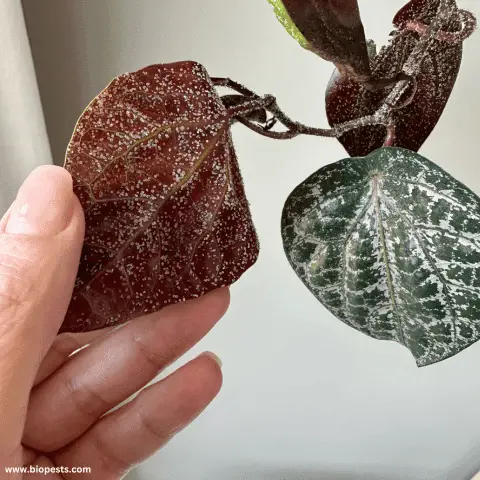
Piper Crocatum Vs Piper Ornatum. What’s the difference?
The Piper crocatum and the Piper ornatum belong to the same family, and people often confuse each other. The two plants are very similar, the main difference being the color of the back of the leaves. It is pale green for the Piper ornatum, while purple/burgundy for the Piper crocatum. The most sought-after plant is the Piper crocatum due to its bright colors, but it is often erroneously referred to as ornatum.
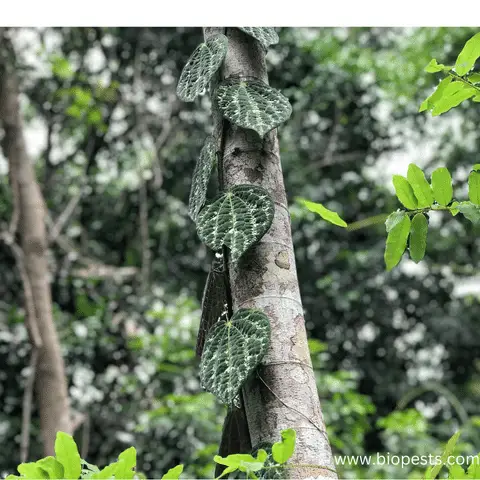
Is Piper Crocatum An Aroid
The Piper crocatum is an aroid, meaning it belongs to the commonly known family of Araceae. Like most aroids, it belongs to the tropical genus. Its leaves are very showy and colorful. The plant does not typically produce flowers when is grown indoors.
Is Piper Crocatum Toxic To Pets?
This plant is known to be slightly toxic to pets, therefore you should keep it out of reach of children and pets at all times, to be safe.
To conclude, this plant will give a sophisticated look wherever you place it, and even though it is not the easiest plant to grow, it is worth knowing more about it. Don’t get discouraged at the beginning! Once you know the plant’s needs, you will see that it will grow relatively quickly and give you a lot of satisfaction. Guaranteed!
Some of the links above are affiliate links, meaning I will earn a commission if you click through and make a purchase at no additional cost to you.

